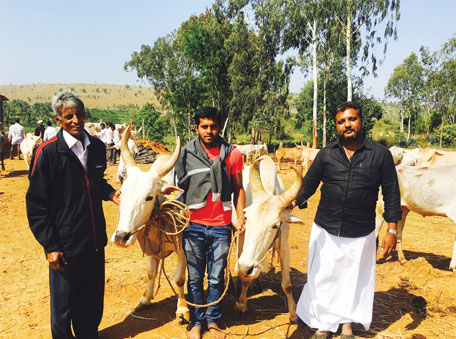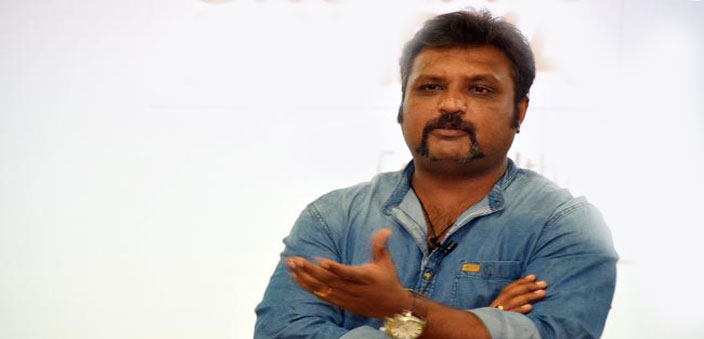To aid in these efforts, the Society has now tied up with a Mandya gaushala (cow protection shelter) to make available cattle for the farmers, in what Madhuchandan describes as a ‘win-win’ situation. In a telephone interview with E. Vijayalakshmi Rajan, he spoke about the reasons behind this, and why he is against cow slaughter.
Tell us about the tie-up with the Mandya gaushala.
A year ago, this gaushala in Mandya approached us for partnership and support. Organic farmers need cows. The much-touted White Revolution introduced the Jersey and Holstein-Friesian (HF) cows, but their mootra (urine) and dung are not useful as we don’t really consider them to be from the cow family. The milk they produce is not of great quality too. Hence, when the gaushala approached us, we thought it would be a win-win partnership. The farmers belonging to the Mandya Organic Farmers Co-operative Society could adopt the native breed cows at the gaushala and thus be able to access cow urine and dung, so necessary for their organic cultivation. In turn, the gaushala would be ensured of proper care for their cattle. Instead of aggregating 300-400 cows at one place, we thought why not distribute them to organic farmers who will take care of the cattle, while having access to cow urine and dung, so necessary for Jivamrita.
What is Jivamrita?
It is a mixture in various proportions, of cow dung, water, cow urine, dicot powder, jaggery and some mud from the fields where the mixture will be used. This is fermented and micro-organisms grow in it. This is not sprayed or used directly on the plants. Rather, it is used on the soil, which increases the fertility of the soil and helps plants to grow well.
What are the other reasons behind this increasing demand for the native breeds of cows?
There is a lot of debate today about whether the A1 protein found in the Jersey and HF cows is good for humans to consume, as opposed to the predominantly A2 protein found in our native or desi breed of cows like Hallikar, Malnad, Gidda, Sindhi and Gir, which is full of goodness. The A1 protein is said to cause many health problems like diabetes etc. Did India have lifestyle diseases like diabetes and gastric issues earlier? We must all revert to milk from the native breeds.

Aren’t gaushala cattle beyond their productive age?
Yes, that’s true. Cows which are meant for slaughter are rescued and kept in gaushalas to live out their lives. But even cows which are beyond their reproductive age continue to be of use to us. Cow dung and urine are very important ingredients in Indian organic farming, as already mentioned. Also, the bullocks are sent for ploughing and to pull carts. We have to also remember that cows like to be around people.So if they are adopted by the farmers, they get to live on farms which is good for their well-being. Cows and bullocks are more economically valuable to farmers for their dung and urine, than they can ever be for their meat. That itself is the best argument against cow slaughter.
Is one cow per farmer enough?
As per a study conducted by Subhash Palekar, the eminent agriculturist, one cow can support up to 30 acres of land. So an organic farmer who gets a cattle, is happy. So far, 300 cows and bullocks have been adopted by our farmers. By the end of the year, we hope that at least 1,000 more will be adopted by the farmers.
There is a lot of brouhaha in the country today about the ban on cow slaughter.
I am completely against cow slaughter. It’s not about religion. The cow gives us so much. All of us have grown up drinking cow’s milk. We still continue to drink it. That’s our connection with this animal, from a very young age onwards. And even once it’s past its prime, it still continues to give so much. For a farmer, the cow and the bull are akin to his mother and father, that’s how much he gets from them. So cow slaughter should definitely be banned.

What about the ban on Jallikattu (a spectator sport where able-bodied men seek to climb on a running bull), that was being sought in Tamil Nadu?
We shouldn’t ban traditional cultural events like the Jallikattu. First of all, those who are asking for a ban on this sport, how can they comment from the outside? Unless you are part of a culture for at least six to seven years, how can you claim to understand it? In Spain, the bull fights end with the death of the bull. In Tamil Nadu, Jallikattu is bull chase, and not a bull fight. Bulls don’t die in Jallikattu.
Our ancestors started this event to showcase and give prominence to the best of the bulls, so that breeders could seek them out to mate with their cows. That’s how the best genes and traits of the native breeds were passed on. It is easy for the intellectuals and the educated to comment on the social media without understanding the reality. Blindly knocking off rituals is wrong.
Tell us about the progress of Organic Mandya 2020?
We have as of date, 4,000 farmers who are part of the Mandya Organic Farmers Co-operative Society. Of this, 2,700 are men and the rest are women farmers. We hope to achieve our target of a fully-organic Mandya district by 2020!


 [/column]
[/column]